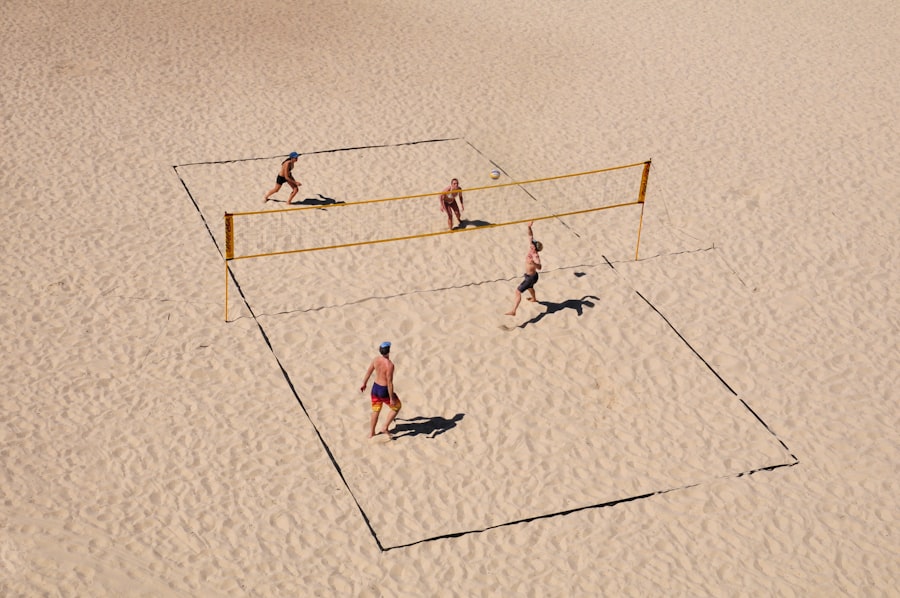Mastering the Art of Volleyball: Tips for Success
Description
Volleyball is a dynamic sport that combines elements of athleticism, strategy, and teamwork. At its core, the game is played between two teams, each consisting of six players, who aim to score points by sending a ball over a net and into the opposing team’s court. The fundamental objective is to ground the ball on the opponent’s side while preventing them from doing the same.
The game is played in sets, with teams needing to reach a predetermined number of points, typically 25, to win a set. Matches are usually played in a best-of-five format, adding an element of endurance and resilience to the competition. The court dimensions and equipment are essential to understanding volleyball.
A standard volleyball court measures 18 meters long and 9 meters wide, divided by a net that stands at a height of 2.43 meters for men and 2.24 meters for women. The ball itself is lightweight, typically weighing between 260 to 280 grams, and is designed for optimal aerodynamics and control. Each player has specific roles, including setters, outside hitters, middle blockers, liberos, and defensive specialists, each contributing unique skills to the team’s overall performance.
Familiarity with these roles and the basic rules of the game is crucial for any aspiring volleyball player.
Key Takeaways
- Volleyball is a team sport played with a ball and a net, with the objective of sending the ball over the net and into the opponent’s court.
- Proper technique and form are essential for successful volleyball play, including proper hand positioning, footwork, and body positioning.
- Improving footwork and agility is crucial for quick movements and effective positioning on the court.
- Mastering the serve and serve receive is important for gaining an advantage over the opponent and controlling the game.
- Communication and teamwork are key components of successful volleyball play, requiring clear and effective communication among team members.
Developing Proper Technique and Form
Mastering proper technique and form is vital for success in volleyball. Each skill—whether it be serving, passing, setting, or spiking—requires specific body mechanics that can significantly impact performance. For instance, when executing a serve, players must focus on their grip, stance, and follow-through.
A well-executed serve begins with a firm grip on the ball, followed by a balanced stance that allows for a powerful arm swing. The follow-through is equally important; it not only affects the ball’s trajectory but also helps prevent injuries by ensuring that the body moves in a controlled manner. In addition to serving, passing is another fundamental skill that demands attention to technique.
Players must learn to position their bodies correctly to receive the ball effectively. This involves bending the knees, keeping the feet shoulder-width apart, and using the forearms to create a stable platform for the ball to contact. The angle of the arms can influence where the ball goes next; thus, players should practice adjusting their body position based on the incoming serve or attack.
Consistent practice of these techniques will lead to improved performance on the court and greater confidence in executing plays during matches.
Improving Footwork and Agility

Footwork and agility are critical components of volleyball that can greatly enhance a player’s effectiveness on the court. Quick and precise foot movement allows players to position themselves optimally for various plays, whether they are preparing to receive a serve or executing an attack. Developing footwork begins with basic drills that emphasize lateral movement, forward and backward sprints, and quick changes in direction.
For example, ladder drills can be particularly effective in improving agility by forcing players to navigate through a series of rungs quickly while maintaining control over their body movements. In addition to ladder drills, incorporating plyometric exercises into training routines can significantly boost explosive power and speed. Exercises such as box jumps or lateral bounds help develop the fast-twitch muscle fibers necessary for quick bursts of movement on the court.
Furthermore, practicing specific volleyball footwork patterns—such as shuffling side-to-side or performing crossover steps—can enhance a player’s ability to react swiftly during gameplay. By focusing on these aspects of footwork and agility, players can improve their overall performance and become more versatile athletes.
Mastering the Serve and Serve Receive
| Player | Aces | Service Errors | Service Points | Service Percentage | Passing Rating |
|---|---|---|---|---|---|
| Player 1 | 10 | 5 | 50 | 80% | 2.5 |
| Player 2 | 8 | 3 | 45 | 75% | 2.3 |
| Player 3 | 12 | 6 | 55 | 85% | 2.7 |
The serve is one of the most critical skills in volleyball, as it initiates each rally and can set the tone for the entire play. There are various types of serves—underhand, overhand, floaters, and jump serves—each requiring different techniques and levels of skill. For instance, a jump serve involves a combination of timing, power, and precision; players must time their jump perfectly to strike the ball at its highest point while ensuring they maintain control over its direction and speed.
Practicing this skill consistently can lead to more effective serves that challenge opponents right from the start. Equally important is mastering serve receive techniques. The ability to effectively receive serves can dictate how well a team transitions from defense to offense.
Players must develop keen anticipation skills to read the server’s body language and predict where the ball will land.
Drills that simulate various serve types can help players practice their positioning and reaction times.
For example, coaches might use a machine to deliver different types of serves at varying speeds, allowing players to adapt their techniques accordingly. By honing both serving and receiving skills, players can significantly impact their team’s performance during matches.
Enhancing Communication and Teamwork
Effective communication is paramount in volleyball; it fosters teamwork and ensures that all players are on the same page during fast-paced gameplay. Players must develop verbal cues and non-verbal signals to convey their intentions clearly on the court. For instance, calling for the ball loudly not only alerts teammates but also establishes ownership over the play.
Additionally, using hand signals or eye contact can enhance coordination during complex plays where multiple players are involved. Teamwork extends beyond communication; it involves understanding each player’s strengths and weaknesses and leveraging them for collective success. Regular team-building exercises can help foster trust among teammates, which is essential for effective collaboration during matches.
Engaging in drills that require players to work together—such as synchronized movements or coordinated attacks—can enhance their ability to function as a cohesive unit. By prioritizing communication and teamwork in practice sessions, teams can create an environment where players feel comfortable supporting one another both on and off the court.
Utilizing Strategy and Game Awareness

Adapting to Opponents’ Strengths and Weaknesses
Coaches often develop specific game plans based on opponents’ strengths and weaknesses; players must be able to adapt their play styles accordingly. For example, if an opposing team has a particularly strong middle blocker, a team might choose to focus on attacking from the outside or utilizing quick sets to bypass that blocker.
Reading the Flow of Play
Game awareness encompasses more than just strategic execution; it also involves reading the flow of play and anticipating opponents’ moves. Players should develop an understanding of when to switch from offense to defense based on ball placement and player positioning.
Improving Decision-Making Skills
This requires constant observation during matches—players must be attuned not only to their own actions but also to those of their opponents. Practicing situational drills that mimic real-game scenarios can help players improve their decision-making skills under pressure, ultimately leading to more effective gameplay.
Strengthening Physical and Mental Conditioning
Physical conditioning is an integral part of any athlete’s training regimen, particularly in a sport as demanding as volleyball.
Strength training exercises targeting key muscle groups—such as legs, core, and shoulders—can enhance power during jumps and spikes while also reducing injury risk.
Incorporating resistance training with free weights or bodyweight exercises can help develop these essential muscle groups. Mental conditioning is equally important in volleyball; athletes must cultivate resilience and focus to navigate the pressures of competition effectively. Techniques such as visualization can be beneficial; players might visualize themselves successfully executing specific plays or overcoming challenges during matches.
Additionally, mindfulness practices can help athletes stay present during high-stakes moments when anxiety may arise. Engaging in regular mental conditioning exercises alongside physical training creates well-rounded athletes who are prepared for both the physical demands of volleyball and the mental challenges that accompany competitive play.
Practicing Consistently and Setting Goals
Consistency in practice is key to mastering any sport, including volleyball. Regular training sessions allow players to refine their skills continually while building muscle memory essential for executing techniques under pressure during matches. Establishing a structured practice schedule that includes skill drills, conditioning exercises, and scrimmages can help players stay focused on their development goals.
Setting specific, measurable goals is another critical aspect of consistent practice. Goals should be realistic yet challenging; they might include improving serving accuracy by a certain percentage or increasing vertical jump height within a specified timeframe. By breaking down larger objectives into smaller milestones, players can track their progress more effectively while maintaining motivation throughout their training journey.
Regularly revisiting these goals ensures that athletes remain committed to their development while fostering a growth mindset that encourages continuous improvement in all aspects of their game.
If you’re a fan of volleyball, you may also be interested in learning about the latest trends in social media. Check out this article on TikTok to see how this platform is changing the way we interact online. Whether you’re looking for volleyball tips or just want to stay up-to-date on the latest social media crazes, this article has something for everyone.
FAQs
What is volleyball?
Volleyball is a team sport in which two teams of six players are separated by a net. The objective is to score points by grounding the ball on the opposing team’s court.
What are the basic rules of volleyball?
The basic rules of volleyball include serving the ball over the net, rallying to keep the ball in play, and trying to score points by making the ball land in the opposing team’s court.
What are the different types of volleyball games?
There are several variations of volleyball, including indoor volleyball, beach volleyball, and sitting volleyball (for athletes with disabilities). Each variation has its own set of rules and playing environment.
What equipment is needed to play volleyball?
The main equipment needed to play volleyball includes a volleyball, a net, and appropriate footwear. Players may also wear knee pads and other protective gear.
What are the health benefits of playing volleyball?
Playing volleyball can improve cardiovascular health, enhance muscle strength and coordination, and promote teamwork and social interaction. It is also a great way to stay active and have fun.
What are the key skills needed to play volleyball?
Key skills needed to play volleyball include serving, passing, setting, attacking, blocking, and digging. Players also need good communication and teamwork skills to be successful in the game.





